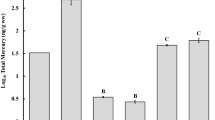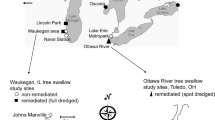Abstract
To evaluate mercury (Hg) exposure and possible adverse effects of Hg on American dipper (Cinclus mexicanus) reproduction, we collected eggs and nestling feathers and the larval/nymph form of three Orders of aquatic macroinvertebrates (Ephemeroptera, Plecoptera and Trichoptera = EPT) important in their diet from three major headwater tributaries of the upper Willamette River, Oregon in 2002. The Coast Fork Willamette River is contaminated with Hg due to historical cinnabar (HgS) mining at the Black Butte Mine; the Row River is affected by past gold-mining operations located within the Bohemia Mining District, where Hg was used in the amalgamation process to recover gold; and the Middle Fork Willamette River is the reference area with no known mining. Methyl mercury (MeHg) concentrations (geometric mean) in composite EPT larvae (111.9 ng/g dry weight [dw] or 19.8 ng/g wet weight [ww]), dipper eggs (38.5 ng/g ww) and nestling feathers (1158 ng/g ww) collected from the Coast Fork Willamette were significantly higher than MeHg concentrations in EPT and dipper samples from other streams. Total mercury (THg) concentrations in surface sediments along the same Hg-impacted streams were investigated by others in 1999 (Row River tributaries) and 2002 (Coast Fork). The reported sediment THg concentrations paralleled our biological findings. Dipper breeding territories at higher elevations had fewer second clutches; however, dipper reproductive success along all streams (including the lower elevation and most Hg-contaminated Coast Fork), was judged excellent compared to other studies reviewed. Furthermore, MeHg concentrations in EPT samples from this study were well below dietary concentrations in other aquatic bird species, such as loons and ducks, reported to cause Hg-related reproductive problems. Our data suggest that either dipper feathers or EPT composites used to project MeHg concentrations in dipper feathers (with biomagnification factor of 10–20×) may be used, but with caution, to screen headwater streams for potential Hg-related effects on dippers. When actual feather concentrations or projected feather concentrations are equal to or lower than concentrations reported for the Coast Fork, dippers are expected to reproduce well (assuming adequate prey and suitable nest sites). When Hg concentrations are substantially higher, more detailed investigations may be required. Birds feeding almost exclusively on fish (e.g., osprey [Pandion haliaetus]) and usually found further downstream from the headwaters would not be adequately represented by dippers given the higher MeHg concentrations in fish resulting from biomagnification, compared to lower trophic level invertebrates.


Similar content being viewed by others
References
Altman, B., Hanson, C.M. and Waite, I.R. (1997). Summary of information on aquatic biota and their habitats in the Willamette Basin, Oregon, through 1995. USGS Water Resources Investigations Report 97-4023, 174 pp
Bakus G.J., (1959a). Territoriality, movements, and population density of the dipper in Montana Condor 61: 410–25
Bakus G.J., (1959b). Observations on the life history of the dipper in Montana Auk 76: 190–206
Barr, J.F. (1986). Population dynamics of the common loon (Gavia immer) associated with mercury-contaminated waters in northwestern Ontario. Canadian Wildl. Serv. Occas. Paper 56, 23 pp
Becker P.H., Furness R.W., Henning D., (1993). Mercury dynamics in young common tern (Sterna hirundo) chicks from a polluted environment Ecotoxicology 2: 33–40
Blus L.J., (1984). DDE in birds’ eggs: comparison of two methods for estimating critical levels Wilson Bull. 96: 268–76
Bouton S.N., Frederick P.C., Spalding M.G., Gill H., (1999). Effects of chronic low concentrations of dietary methylmercury on the behavior of juvenile great egrets Environ. Chem. Toxicol. 18: 1934–9
Brooks, H.C. (1963). Quicksilver in Oregon, Bulletin No. 55. Dept. Geology and Mineral Industries, Portland, Oregon, 221 pp
Brooks, H.C., Ramp, L. (1968). Gold and silver in Oregon, Bulletin 61. Dept. Geology and Mineral Industries, Portland, Oregon, 337 pp
Brooks, H. (1971). Quicksilver deposits in Oregon, Misc. Paper No. 15. Dept. Geology and Mineral Industries. Portland, OR
Brumbaugh, W.G., Krabbenhoft, D.P., Helsel, D.R., Wiener, J.G. and Echols, K.R. (2001). A national pilot study of mercury contamination of aquatic ecosytems along multiple gradients: bioaccumulation in fish. USGS Biological Science Report 2001-0009, 25 pp
Bureau of Land Management (BLM) (1997). Cottage Grove/Big River, Row River, and Sharps Creek Watershed Analysis, Eugene District Office (http://www.edo.or.blm.gov)
Cain, D.J., Fend, S.V. and Carter, J.L. (1989). Temporal and spatial variability of arsenic in benthic insects from Whitewood Creek, South Dakota. In G.E. Mallard and S.E. Ragone (eds), U.S. Geological Survey Toxic Substances Hydrology Program – Proceedings of the Technical Meeting, Phoenix, Arizona, September 26–30, 1988. USGS Water-Resources Investigations Report 88–4220, pp. 257–68
Crawford, J.K. and Luoma, S.N. (1993). Guidelines for studies of contaminants in biological tissues for the National Water-Quality Assessment Program. USGS Open-File Report 92-494, 69 pp
Curtis, L.R. (2003). Sources and chronology of mercury contamination in Cottage Grove Reservoir. Final Report, Oregon State Univ., Corvallis, 43 pp
DeWilde, J.F., Olson, M.L. and Olund, S.D. (2002). Determination of methyl mercury by aqueous phase ethylation, followed by gas chromatographic separation with cold vapor atomic fluorescence detection. USGS Open-File Report 01-445, Middleton, WI, 14 pp
Ealey, D.M. (1977). Aspects of the ecology and behavior of a breeding population of dippers (Cinclus mexicanus: Passeriformes) in southern Alberta. M.S. Thesis. Univ. Alberta, Edmonton
Environmental Protection Agency (EPA) (1999). Black Butte Mine site inspection report, TDD: 98-04-0004, Seattle, WA
Environmental Protection Agency (EPA) (2002). Method 1631, Revision E: Mercury in water by oxidation, purge and trap, and cold vapor atomic fluorescence spectrometry. EPA-821-R-02-019, Washington DC, 38 pp
Fite, M.K. (1984). Vocal behavior and interactions among parents and offspring in the American dipper. M.S. Thesis. Utah State Univ., Logan
Gustina, G.W., Boyle, T.P. and Kondratieff, B.C. (2000). Response of benthic macroinvertebrate community metrics in two ecoregions and at three levels of taxonomic resolution. Proc. 48th Meeting of No. American Benthological Society, Keystone, CO
Hawthorne V.M., (1979). Use of nest boxes by dippers on Sagehen Creek, California West. Birds 10: 215–6
Heinz G.H., (1979). Methylmercury: reproductive and behavioral effects on three generations of mallard ducks J. Wildl. Manage. 43: 394–401
Henny C.J., Hill E.F., Hoffman D.J., Spalding M.G., Grove R.A., (2002). Nineteenth century mercury: hazard to wading birds and cormorants of the Carson River, Nevada Ecotoxicology 11: 213–31
Hughes K.D., Ewins P.J., Clark K.E., (1997). A comparison of mercury levels in feathers and eggs of osprey (Pandion haliaetus) in the North American Great Lakes Arch. Environ. Contam. Toxicol. 33: 441–52
Hygelund B.N., Ambers R.K., Ambers C.P., (2001). Tracing the source of mercury contamination in the Dorena Lake watershed, western Oregon Environ. Geol. 40: 853–9
Kingery, H.E. (1996). American dipper (Cinclus mexicanus). In A. Poole and F. Gill (eds), Birds of North America, No. 229. Acad. Nat. Sci., Philadelphia, PA, and American Ornithologists’ Union, Washington, DC
Klemm D.J., Blocksom K.A., Thoeny W.T., Fulk F.A., Herlihy A.T., Kaufmann P.R., Cormier S.M., (2002). Methods development and use of macroinvertebrates as indicators of ecological conditions for streams in the mid-Atlantic highlands region Environ. Monit. Assess. 78: 169–212
Klett, A.T., Duebbert, H.F., Faanes, C.A., Higgins, K.F. (1986). Techniques for studying nest success of ducks in upland habitats in the prairie pothole region. US Dept. of the Interior. Fish and Wildl. Service. Resource Publ. 158, 25 pp
Lewis S.A., Furness R.W., (1991). Mercury accumulation and excretion in laboratory reared black-headed gull, Larus ridibundus, chicks Arch. Environ. Contam. Toxicol. 21: 316–20
Loegering, J.P. (1997). Abundance, habitat association and foraging ecology of American dippers and other riparian-associated wildlife in the Oregon Coast Range. Ph.D. Dissertation. Oregon State University, Corvallis
Mayfield H.F., (1975). Suggestions for calculating nest success Wilson Bull. 87: 456–66
Merritt R.W., Cummins K.W., (1984). An introduction to the aquatic insects of North America (2nd edn). Kendall/Hunt Publishing Co., Dubuque, Iowa. 722 pp.
Moore J.N., Luoma S.N., Peters D., (1991). Downstream effects of mine effluent on an intermontaine riparian system Can. J. Fish. Aquat. Sci. 48: 222–32
Morrissey, C.A. (2003). The ecological and toxicological significance of altitudinal migration by the American dipper (Cinclus mexicanus). Ph.D. Dissertation. Simon Fraser Univ., Burnaby, British Columbia, Canada
Morrissey C.A., Bendall-Young L.I., Elliott J.E., (2004a). Linking contaminant profiles to the diet and breeding locations of American dippers using stable isotopes J. Appl. Ecol. 41: 502–12
Morrissey C.A., Bendall-Young L.I., Elliott J.E., (2004b). Seasonal trends in population density, distribution, and movement of American dippers within a watershed of southwestern British Columbia, Canada Condor 106: 815–25
Moulton, S.R. II, Kennen, J.G., Goldstein, R.M. and Hambrook, J.A. (2002). Revised protocols for sampling algae, invertebrate, and fish communities as part of the National Water-Quality Assessment Program. USGS Open-File Report 02-150
Newton I., Haas M.B., (1988). Pollutants in merlin eggs and their effects on breeding British Birds 81: 258–69
Ormerod S.J., Tyler S.J., (1990). Environmental pollutants in the eggs of Welsh dippers Cinclus cinclus: a potential monitor of organochlorine and mercury contamination in upland rivers Bird Study 37: 171–6
Ormerod S.J., Tyler S.J., (1992). Patterns of contamination by organochlorines and mercury in the eggs of two river passerines in Britain and Ireland with reference to individual PCB congeners Environ. Pollut. 76: 223–43
Orr E.L., Orr W.M., Boldwin E.M., (1992). Geology of Oregon, Lendall Hunt Publishing Co., Dubuque, IA
Park, J.G. (1996). Point and nonpoint source mercury pollution of Oregon reservoirs. Ph.D. Dissertation. Oregon State Univ., Corvallis
Park J.G., Curtis L.R., (1997). Mercury distribution in sediments and bioaccumulation by fish in two Oregon reservoirs: point-source and nonpoint-source impacted systems Arch. Environ. Contam. Toxicol. 33: 423–9
Price F.E., Bock C.E., (1983). Population Ecology of the Dipper (Cinclus mexicanus) in the Front Range of Colorado. Studies in Avian Biology, 7, Cooper Ornithological Society
SAS Institute (1999). SAS User’s Guide: Statistics, Version 8.0 Edition. SAS Institute, Inc., Cary, NC
Sorace A., Formichetti P., Boano A., Andreani P., Gramegna C., Mancini L., (2002). The presence of a river bird, the dipper, in relation to water quality and biotic indices in central Italy Environ. Poll. 118: 89–96
Strom S.M., Ramsdell H.S., Archuleta A.S., (2002). Aminolevulinic acid dehydratase activity in American dippers (Cinclus mexicanus) from a metal-impacted stream Environ. Toxicol. Chem. 21: 115–20
Suedel B.C., Boraczek J.A., Peddicord R.K., Clifford P.A., Dillon T.M., (1994). Trophic transfer and biomagnification potential of contaminants in aquatic ecosystems Rev. Environ. Contam. Toxicol. 136: 21–89
Sullivan, J.O. (1973). Ecology and behavior of the dipper, adaptations of a passerine to an aquatic environment. Ph.D. Dissertation. Univ. Montana, Missoula
Thompson D.R., (1996). Mercury in birds and terrestrial mammals. In: Beyer W.N., Heinz G.H., Redmon-Norwood A.W., (Eds.) Environmental Contaminants in Wildlife – Interpreting Tissue Concentrations, Lewis Publ. Boca Raton, FL pp. 341–56
Tyler S.J., Ormerod S.J., (1985). Aspects of the breeding biology of dippers in the southern catchment of the River Wye, Wales Bird Study 33: 164–9
Tyler, S.J. and Ormerod S.J. (1994). The dippers. T & AD Poyser Ltd., London, 219 pp
Westerskov K., (1950). Methods for determining the age of game bird eggs J. Wildl. Man. 14: 56–67
Acknowledgments
We appreciate the assistance of Ian R. Waite, USGS, Water Resources Division, Portland, who showed us how to properly collect invertebrates and identified the voucher specimens. Lawrence R. DeWeese, USGS NAWQA Program, Denver, suggested the study and facilitated the funding. An earlier draft of the manuscript was improved by the thoughtful comments of Elwood F. Hill, Dennis A. Wentz, and Lawrence R. DeWeese. George W. Lienkaemper kindly prepared the map.
Author information
Authors and Affiliations
Corresponding author
Rights and permissions
About this article
Cite this article
Henny, C.J., Kaiser, J.L., Packard, H.A. et al. Assessing Mercury Exposure and Effects to American Dippers in Headwater Streams near Mining Sites. Ecotoxicology 14, 709–725 (2005). https://doi.org/10.1007/s10646-005-0023-7
Accepted:
Published:
Issue Date:
DOI: https://doi.org/10.1007/s10646-005-0023-7




